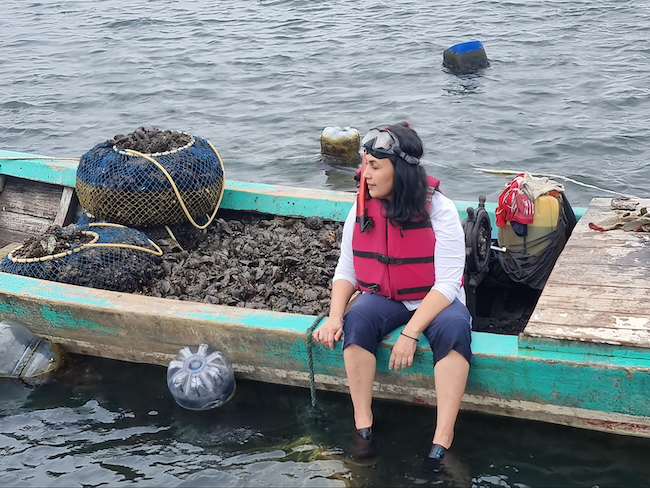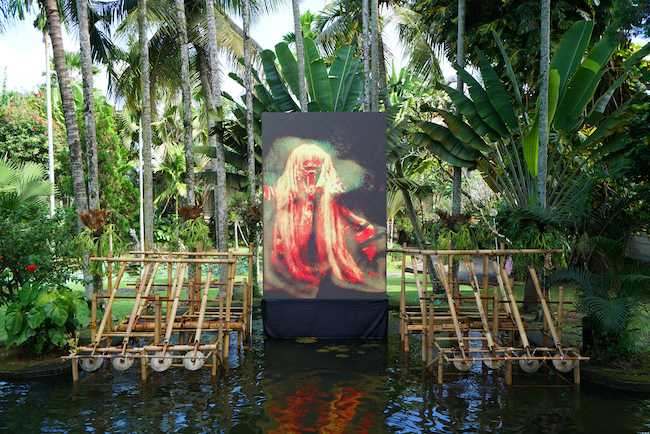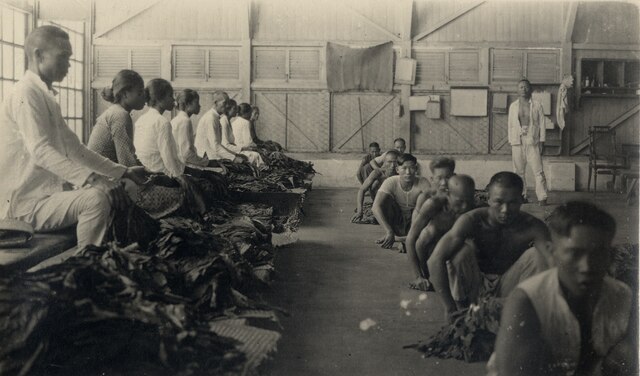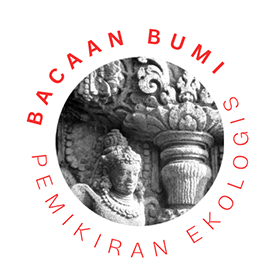Indah Arsyad’s Balinese perspective
Natasha Doroshenko Murray
At Indonesia Bertutur 2024, a biannual festival exploring Indonesia’s cultural heritage through contemporary art, the historic gardens of Bali’s Museum Puri Lukisan became the stage for Amrta, a multimedia installation by artist Indah Arsyad. First held in 2022 at the Borobudur Temple complex in Central Java, the festival moves locations with each edition, creating site-specific dialogues between artists, historians, and cultural practitioners.
Amrta integrates cultural ritual, ecological consciousness, and technological innovation. Rooted in mythological symbolism and environmental data, the installation invites the viewers to engage with the living landscape of Bali and the ecological principles that sustain it.
Artist’s journey to science-based art
Arsyad’s journey into environmental art began with an intensely personal experience during the COVID-19 pandemic, which profoundly shaped her artistic focus. ‘When I was a COVID survivor in 2020, in critical condition, unable to breathe without assistance, I became focused on how the earth would be if it lost oxygen,’ she explains. This pivotal moment led to The Ultimate Breath, a work that delves into the life-giving force of oxygen and its fragility.
The preparation for The Ultimate Breath was both rigorous and deeply collaborative. Arsyad conducted extensive research on phytoplankton, microscopic organisms that produce 70-80 per cent of the earth’s oxygen. Partnering with the Oceanography Research Center of the Indonesian Institute of Sciences, she explored the critical role phytoplankton plays in sustaining life and how it is endangered by pollution. Her research took her to coastal areas of Jakarta Bay and Cirebon, where blooming algae - triggered by industrial and household waste - had transformed these ecosystems into sites of environmental degradation. Alongside scientists, Arsyad engaged in dialogue with fishermen, whose firsthand experiences illuminated the cascading effects of pollution on marine life and local livelihoods.

This meticulous inquiry marked a turning point in Arsyad’s practice, steering her toward a broader exploration of the intersections between art, science, and environmental advocacy.
Research and collaboration
In creating Amrta, Arsyad drew on a multifaceted research process developed during her residency with Indonesia Bertutur. She investigated the reduction of agricultural land, often replaced by industrial developments, and how this process contributes to fading traditions and environmental pollution. Her research combined field studies with scientific inquiry. Field research included dialogues with farmers, Pekaseh (Subak leaders), Mangku (Balinese Hindu priests), ritual dancers, puppeteers, and local communities, exploring the lived realities of environmental and cultural shifts. Scientific research examined the polluted waters of the Pakerisan tributary, a river originating from the sacred spring of Lake Batur in Kintamani.
Using IoT (Internet of Things) technology - a system where everyday objects, equipped with sensors and internet connectivity, collect and exchange data, allowing them to interact autonomously, much like how computers and smartphones communicate online - the research tracked real-time data across three elements of Trilingga. This Balinese cosmological concept is centered on Water, Wind, and Fire, and thus the system was measuring pH levels to assess water pollution, monitoring carbon dioxide concentrations in the air, and tracking temperature fluctuations to understand broader environmental impacts.
A dance of nature
Set within a bamboo framework, Amrta incorporates traditional Balinese musical instruments - reong and rindik - within a mechanised system that channels water through hollow bamboo tubes. Bamboo arms, activated by environmental data from the Pakerisan River, rise and fall to strike the instruments, creating a soundscape that, while chaotic, resonates with the tonal complexity of gamelan music. At the centre of the installation, a spectral figure of Rangda, the queen of Leyaks from the Calonarang dance drama, moves across a screen. Her ghostly dance, shaped by fluctuations in environmental data, reflects the fragility of Bali’s natural systems: the pH of the river influences her movements, carbon dioxide levels affect particle stimulation, and temperature shifts alter the colours in the visuals.

'Channeling the supernatural powers of the goddess Durga - a figure often seen as a symbol of Mother Earth herself, the dancing emanation of Amrta also represents the anger of women,' Arsyad explains. In the context of Bali’s environmental erosion, it’s hard not to read it as a caution of maternal wrath, where Mother Nature, as a caretaker, may be finally compelled to unleash her fury upon her disobedient children to restore balance.
The presence of traditional dance and music in Amrta also points towards another kind of erosion - a cultural one. For many visitors, accustomed to experiencing traditional Balinese dance as a commodified spectacle in hotels and restaurants, it is easy to forget that these performances are deeply embedded in the spiritual life of the Balinese community. They are not merely aesthetic but are fundamentally acts of cultural and religious significance. As this year’s festival curator, Melati Suryodarmo, points out, ‘transplanting a ritual onto a stage strips it of its inherent meaning.’ The very allure that draws people to Bali is being eroded by this enchantment-without-understanding.
Arsyad, a Javanese artist researching and creating works related to Balinese culture, also explores the shared threads between the two traditions. ‘I try to connect Javanese and Balinese cultures, focusing on the similarities in traditional rituals,’ she notes. For example, gamelan plays a central role in dance performances in both traditions, forming a bridge between these cultural practices. Rangda, too, has cross-cultural resonance. A central figure in the Calonarang dance drama, Rangda’s origins can be traced back to Javanese folk tales, such as those found in the Jaha inscription from 840 AD. In Bali, her story evolved, with the golden age of Calonarang performances emerging during the Gelgel period (1460–1550) and documented in the Lontar Prasraya. Through these connections, Arsyad weaves together the cultural narratives of Java and Bali, enriching Amrta with layers of shared history and symbolism.
Through Amrta, Arsyad pays homage to Bali’s Subak irrigation system, which was also the theme of the Bertutur Festival in 2024. A UNESCO-protected model of sustainable agriculture, Subak is entwined with the Trihitna Karana philosophy, emphasising harmony among humans, nature, and the divine. Amrta’s moving bamboo arms evoke Tluktak, a Subak’s water management system that uses bamboo to distribute water evenly in rice field irrigation. The evocation of this principle of mutual cooperation, resonating with the Indonesian ethos of gotong royong - a philosophy of communal self-governance and collective responsibility - invites a hopeful extrapolation: environmental care, much like Subak, requires collaborative stewardship rather than isolated interventions - a vital approach to addressing Bali’s devastating environmental challenges which place the entire Subak system under threat.
Myth, magic, and technology in harmony
The title Amrta, meaning ‘immortality’ or ‘nectar’ in Sanskrit, reflects Arsyad’s aspiration for a balanced, sustainable relationship with the Earth. ‘The life energy called Amrta is the most sacred, purest energy, which cannot be other than in the center of nature,’ she notes, positioning the installation as a rather hopeful tale, even if it is deeply cautionary. In Amrta, technology is not used to dominate or exploit but to interpret nature, translating its language for a humanity so distant from the natural world that we can no longer hear it speak. Rather than inventing a new framework, Arsyad revives the languages of myth and magic, which once helped humans understand their place in the world.
This connection resonates with anthropologist Ernesto de Martino, who described ritual as a way to ground humanity in a fragmented world. He warned of a 'crisis of presence,' a state where rapid scientific and technological advancements dislocate our sense of belonging in this world. Arthur C. Clarke’s famous observation - ‘Any sufficiently advanced technology is indistinguishable from magic’ - also finds relevance in Amrta. As Arsyad explains, ‘Through research between environmental pollution, mythology, and technology, this work serves as a bridge. Long ago, myth and ancestral practices were the main vehicles of science. I don’t see why they cannot be like that in the present day,’ she insists. ‘Technology must be used in conjunction with a deep respect for nature and an understanding of the ancient wisdom that has guided humans for centuries.’
By bridging ancient knowledge and modern technology, Arsyad’s Amrta reminds us that the future lies not in separating the natural and the human-made, but in uniting them. Amrta serves both as a cautionary tale and a hopeful vision, inviting humanity to relearn how to listen to nature’s rhythms and reclaim its own forgotten wisdoms.
Natasha Doroshenko Murray (hello@artcircle.asia) is a curator and researcher based in Bali, Indonesia. She explores the intersection of contemporary art, environmental sustainability, and cultural preservation in Southeast Asia. An interview with Indah Arsyad for this article was conducted with the assistance of Jessica Zheng.










